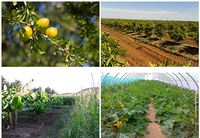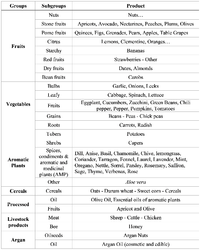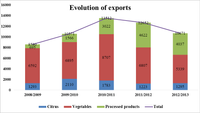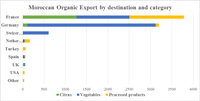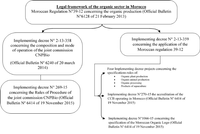Country report: Organic Agriculture development in Morocco
Morocco has a significant horticultural production, and the organic sector has grown rapidly since its establishment in 1986. AMABIO, the Moroccan Association of Organic Production Chain Value, is a driving force, offering technical assistance to farmers and working towards the government on development strategies for organic agriculture in Morocco.
From citrus to argan oil
Initiated in 1986, the first export of organic commodities was citrus. Later, exports extended to vegetables, medicinal and aromatic plants and other exotic products. Between 1990 and 1994, organic growers were particularly active in the development of the organic sector in Morocco, by the rapid increase in the cultivated lands they had allocated to the production of fruits and vegetables, which increased from a few hectares in 1990 to over 300 ha in 1999. In 1998, another category of organic growers appeared: Smallholders within cooperatives in the rural and mountain area. They were assisted by NGOs to launch marketing operations of organic medicinal and aromatic plants collected in forests. Argan forest was also subject to regulatory certification, and the oil is currently marketed as endemic argan oil of Morocco. During the last decade, the areas dedicated to organic farming increased significantly, from 8 300 ha in 2003 to 870 000 ha in 2013 (including argan forest), a growth rate of 54% per year.
Low-input, high-labor and local varieties
Morocco has some strengths in agricultural production that promote the emergence of organic farming. The land and the climate are suitable for the production of off-season products for EU markets. Easy access to labor is another strength in the Moroccan agricultural production. The persistence of traditional agriculture has allowed the conservation of farmers' expertise on "natural" (low input) production. In all Moroccan regions, especially in the High Atlas, local varieties have been conserved in a dynamic way by farmers since centuries. Farmers have been able to select varieties resistant to diseases and pests and adapted to local environmental conditions. Self-seeds reproduction on farms has remained predominant in these areas.
Constraints
While organic production in recent years has developed significantly in terms of area, production and export, particularly for crops, many constraints remain and can be summarized as follows:
- The conversion period of 2 to 3 years, during which productivity declines and the product is not valued
- The increase in production costs caused by high costs of certification, currently performed by foreign regulators;
- The scarcity of authorized inputs, including bio-pesticides and composts in the domestic market as well as seeds and plants used in organic farming;
- Lack of subsidies for professional entities (farmers, cooperatives...) ensuring the take-off of the sector;
- Lack of communication and promotion of organic products by government entities in both national and foreign markets;
- The lack of a domestic market for organic products, although there is a significant potential national demand.
Driving organization: AMABIO
From the database provided by the inspection and certification bodies operating in Morocco, the current area of organic crops is about 870 000 hectares. This certified organic area is managed by 260 entities (farmers, companies, cooperatives...) throughout the country.
The Moroccan Association of Organic Production Chain Value (AMABIO) was created in 2010. Its mission is to define and implement together with the government a strategy for the future development of organic agriculture. It also offers technical assistance to farmers and engages in the extension of good practices. Moreover, AMABIO promotes the consumption of Moroccan organic products both nationally and internationally. AMABIO brings together all the operators in the sector including producers and processors, exporters of fresh and processed organic products; inspection and certification bodies; suppliers of organic inputs; researchers and extension society; non-governmental associations and organizations (NGOs) promoting the organic sector, environmental protection and sustainable development.
The government and AMABIO signed in April 2011, a program contract up to 2020 for the development of the organic sector. A program of investment up to 100 M€ was signed, to boost the implementation of operations in order to reach the following objectives:
OBJECTIVES 2020 | |||
Situation 2011 | Objectives 2020 | Increment | |
Surface (Ha) | 4 000 | 40 000 | 36 000 |
Production (T) | 40 000 | 400 000 | 360 000 |
Exports (T) | 10 000 | 60 000 | 50 000 |
Income in foreign currency (millions €) | 8.93 | 71.43 | 62.50 |
Job creation (millions of working days) | 1 | 9 | 8 |
The program contract is based on the following axes to reach the objectives:
- Development of the research and extension actions;
- Improvement of the conditions of valorization, marketing and promotion for organic products in the domestic market
- Development and promotion of the export sector;
- Improvement of the professional condition framework.
The Moroccan Ministry of Agriculture has developed an organic national regulation (N°39-12 published in February 2013), in coordination with AMABIO. Operators (farmers) have until now certified their products through private certification and control bodies (five are currently operating) since no national body was available, but this will now change since implementing decrees relative to the organic national regulation have been published. The national authority for approving certification bodies is the Moroccan Accreditation Service (SEMAC).
Operators (farmers) purchase seeds, fertilizers and other inputs from companies that import most materials from the EU. There is a real need for a professional association of companies that import and distribute organic inputs to the organic operators. Such an association should defend the farmers' rights to reduced taxes on imported organic inputs, which are currently at the same level as conventional inputs. In addition, production of Moroccan organic inputs should be encouraged by government entities to decrease the high costs of inputs especially for smallholders.
High diversity of organic crops
Moroccan organic farming is divided in seven sub-sectors of products, as shown in Table 1.
Table 1. Groups of organic crops produced in Morocco, with sub-groups and main products.
The soil and climate diversity offer a wide range of products. Most of them are grown naturally without any
treatment what give them high potentiality to be easily certified to organic products.
Large proportion of wild collection
In Morocco, organic cultivated land area comprises about 8 046 hectares, while the wild collection certified area is 861 690 hectares with 1 840 hectares in conversion by 2015. The cultivated land comprises only 0.08% of the Moroccan utilized agricultural area (UAA), whereas for the areas of wild collection, organic lands exceeds 9 % of the national area. This is well above the world average of 0.9%.
The distribution of organic crops within the cultivated and wild collected areas are shown in Table 2.
Crop | Certified | Certified wild | Conversion (ha) | Total Area | Total area |
Apricots | 88 | 88 | 0,01 | ||
Citrus | 760 | 70 | 830 | 0,10 | |
Arbutus | 150 | 150 | 0,02 | ||
Argan | 507 | 630000 | 630507 | 72,34 | |
Avocado | 100 | 100 | 0,01 | ||
Prickly pear | 44000 | 44000 | 5,05 | ||
Capers | 770 | 82 | 852 | 0,10 | |
Carob | 1322 | 1322 | 0,15 | ||
Cereals | 132 | 100 | 232 | 0,03 | |
Vegetable crops | 942 | 28 | 970 | 0,11 | |
Grenades | 60 | 60 | 0,01 | ||
Legumes and forages | 356 | 356 | 0,04 | ||
Mint / verbena | 157 | 106 | 263 | 0,03 | |
Olivier | 1070 | 128 | 1198 | 0,14 | |
Date palm | 200 | 200 | 0,02 | ||
Aromatic and medicinal plants | 1686 | 186000 | 108 | 187794 | 21,55 |
Plums | 12 | 12 | 0,00 | ||
Pink | 480 | 480 | 0,06 | ||
Saffron | 48 | 136 | 181 | 0,02 | |
Vine | 55 | 55 | 0,01 | ||
Other | 274 | 770 | 882 | 1926 | 0,22 |
Total | 8046 | 861690 | 1840 | 871576 | 100 |
Table 2. Distribution of cultivated and wild collected crops in certified organic areas of Morocco.
Wild collection is predominant in land area what prove that inhabitants of rural area respect their environment.
The main national organic products are the argan tree (72%) and AMP (22%), with 94% of the organic UAA. The cultivated area is shared between AMP (21%), carob (16%), olive (13%) and vegetable crops with (12%).
Table 3 presents the various crops produced during 2012/2013.
Crop | Certified organic area (ha) | Production (T) | Production % |
Apricots | 88 | 1330 | 1,77 |
Citrus | 760 | 15200 | 20,27 |
Avocado | 100 | 1300 | 1,73 |
Carob | 1322 | 9260 | 12,35 |
Cereals, legumes and forages | 488 | 7808 | 10,41 |
Vegetable crops | 942 | 21680 | 28,91 |
Grenades | 60 | 240 | 0,32 |
Mint / verbena | 157 | 940 | 1,25 |
Olivier | 1070 | 3210 | 4,28 |
Aromatic and medicinal plants | 1686 | 10116 | 13,49 |
Plums | 12 | 160 | 0,21 |
Pink | 480 | 576 | 0,77 |
Saffron | 48 | 0,3 | 0,00 |
Vine | 55 | 880 | 1,17 |
Other | 274 | 2300 | 3,07 |
TOTAL | 7539 | 75000,3 | 100 |
Table 3. Distribution of cultivated organic certified crops in Morocco 2012/13 within crop species.
Even vegetables and citrus represent only 0.21% of the organic UAA, they represent quit 50% of the total production.
High market demand, higly skilled farmer of off-season opportunities are suffiecient ingredient for this success.
Exports: Citrus dominated
The export-oriented activities generate substantially all revenues of the national organic sector. In 2013, the export volume reached 10671 tons. Citrus dominates the exports, mainly "Maroc Late" variety (49%), and zucchini dominates within the vegetables (37%). For processed products, orange juice dominates (38%). Main changes in export trends are shown in Figure 1.
Figure 1. Distribution of products within organic exports from Morocco 2009-2014. There is a need to develop processing plants in order to absorb the excess of fresh vegtables.Catering and school canteen could be an excellent opportunity to outflow processed organic foods in domestic market.
Domestic exports experienced a remarkable growth from 2009 to 2011, with 13 512 tons. Since 2012, the volume has decreased, especially for fresh vegetables. The EU is the main destination market. France, Germany and Switzerland were the first European importers of organic produce from Morocco. France imports almost 90% of citrus and 79% of processed products. Germany is the leading importer of early vegetables with 61% of the volume of this category (Figure 2).
Figure 2. Distribution of exports of organic produce form Morocco between countries.
National regulations in place
At national level, a legal framework was established to regulate the organic sector through the adoption in February 2013 of the law N°39-12 of organic production of agricultural and aquatic products (see Figure 3). The law defines the following key points: The scope and definitions; rules of production, preparation and marketing of organic products; the National Commission for Organic Production (CNPBio); the accreditation of certification bodies of organic products; and the labeling requirements.
Figure 3. Overview of the Legal framework of the organic sector in Morocco. Even if the legal framework is almost complete, the implementing decree of subsidies is necessary for a consistent take-off of the organic sector in Morocco in particular for small stakeholder.
A joint commission, CNPBio has been created to write, study and give its opinion on the implementing decrees specific to organic plant and animal products. The CNPBio is an advisory entity, composed of members representing government authorities, research sector such as INRA, INRH, ONSSA, EACCE, ADA, ANDZOA, etc., and relevant professional organizations such as AMABIO. CNPBio will give its opinion on the specifications for organic production, the granting or withdrawal of approvals of regulatory bodies and certification, complaints related to the suspension or revocation of certification and all questions of scientific, technical or legal aspects under the application of the rules on organic production.
Compliance with EU regulations
The European regulation is strict. To export an organic product to Europe, it must be produced and controlled equivalently to EU regulations. If the exporting country is among the countries whose production rules and control are deemed equivalent to EC Regulation 1235/2008 on imports from third parties (Argentina, Australia, Costa Rica, India, Japan, New Zealand, Switzerland and Tunisia); the product is automatically approved. For the other exporting countries (USA, Canada, China, Morocco...etc), organic products are subject to import authorizations within each Member State. Nevertheless, in all cases, the products must be certified and inspected at each stage of production to be exported abroad. Moroccan farmers exporting to EU have until now used the services of a European certification body.
National subsidies for the organic sector
To promote organic farming, the Moroccan government has developed a strategy that aims both to encourage producers to move towards organic production, and then to convert to organic, and to raise awareness among producers and the population in general on the importance of organic farming. The main measure is the grant of the certification costs. However, no subsidy will be paid for certification costs until the implementing decree has been approved by relevant national authorities. Subsidies for certification will be 70% with a threshold of 1000 MAD/ ha for crops, possibly 700 MAD/ ton for animal products, and 1000 MAD / ton for exported processed products. The grant will be given only during the conversion period. The Ministry of Agriculture and Fisheries subsidise agriculture in general by other financial supports for agricultural equipment (drip irrigation) and agricultural inputs, which are freed of tax when imported to Morocco.
Organic research in Morocco
The program contract signed has scheduled funds for R&D estimated up to 6.25 M € until 2020.AMABIO has launched a call for three research and training institutions (INRA-ENAM and IAV) in Morocco to suggest R&D projects. The first three institutional projects are now in their second year, and the impact is already seen in the field. Members of AMABIO are called to express their needs and shape them in subjects to be treated by researchers in order to adjust their research operation to the professional requirements in a dynamic approach.
INRA which is the only government institution dedicated to agronomy research in Morocco is aware about the research in organic sector. Beside its cooperation with AMABIO, a national research program is under consideration in order to develop links between different agroecosystems needs and the experimental sites (24 experimental farms of INRA over Morocco). Soil fertility, composting, organic horticulture, plant protection, plant and animal breeding, socioeconomics... are main topics undergone by INRA’s researchers to answer professional calls. International cooperation with EU research institutions in the framework of CORE Organic and TIPI Organics will be an excellent opportunity to link northern with southern Mediterranean countries to sustain organic research in a globalized world.
Author:
Khalid Azim
Researcher, INRA Morocco
azim.khalid@yahoo.fr
Ramli Hafsa
Engineer, Horticulture Morocco
Relevant links:
http://www.inra.org.ma
http://asapmaroc.com/partenaires/amabio/
